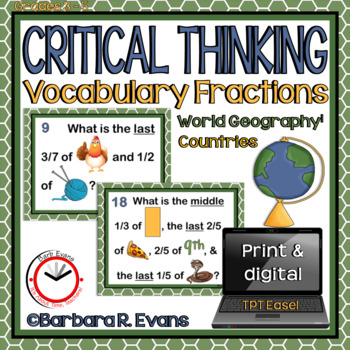CRITICAL THINKING TASK CARDS World Geography Vocabulary Fractions
- PDF
- Internet Activities
- Easel Activity
Also included in
- Exercise your students’ critical thinking with WORLD GEOGRAPHY VOCABULARY FRACTIONS TASK CARDS. In this bundle of 5 VOCABULARY FRACTIONS products, you will find task cards that challenge learners to create geography terms using fractional parts of words. This activity affords your students the chancPrice $10.81Original Price $15.45Save $4.64
Description
Exercise your students’ critical thinking with WORLD GEOGRAPHY VOCABULARY FRACTIONS TASK CARDS. The challenge is to create names of countries using fractional parts of words. This activity affords your students the chance to work with content specific vocabulary while honing skill with fractional parts. The task gradually increases in difficulty, transitioning from 2 part clues with pictures and words to 4 part clues with just pictures. Pupils must deduce the correct word and its spelling. Solving equivalent fractions provides even more challenge. These task cards are offered in print and digitally on TPT Easel.
I strongly advise solving several of these task cards together, “thinking out loud” to model the problem solving required.
This product is CCSS aligned for grades 3 and 4. Fifth graders will also enjoy the challenge.
CONTENTS
- 20 color task cards
- 2 labels for your center storage folder
- 1 direction placard
- 1 recording sheet master
- answer key
- digital version
HOW TO USE THIS PRODUCT
- Have your learners practice their word work and fraction skills independently at a center.
- Guide small groups of students through this activity to give extra practice with the math and vocabulary involved.
- Challenge your entire class to complete these task cards as an anchor activity.
- Use this activity as an enrichment opportunity for advanced students.
- Exercise digital learning by assigning students to complete these task cards on TPT's Easel platform.
You may also like these vocabulary fraction products:
- Forest Friends Vocabulary Fractions Set I (free)
- Forest Friends Vocabulary Fractions Set II
- Christmas Vocabulary Fraction Task Cards
- Spring Vocabulary Fraction Task Cards
- Space Vocabulary Fractions Task Cards
Enjoy!
Barb Evans
CUSTOMER TIPS
- Be the first to know about my new discounts, freebies, and product launches. Click here to follow my store. You will now receive customized email updates about my products.
- Get TPT credit to use on future purchases. Please go to your My Purchases page (you may need to login). Beside each purchase you'll see a Provide Feedback button. Simply click it and you will be taken to a page where you can give a quick rating and leave a short comment for the product. Your feedback is important to me. Thank you in advance.
CONNECT WITH ME







